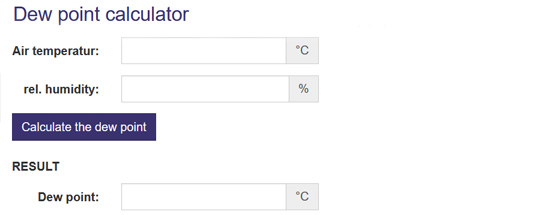
The focus is on room air temperature and relative humidity
Visible mold growth in the apartment always causes discomfort for those affected. After all, no one wants to have the unloved co-inhabitant in their neighborhood. To analyze the causes, it is essential to take a look at the physical relationships in the building. The focus is on room air temperature and relative humidity as well as on the surface temperatures of the surrounding surfaces. Mold always grows when it finds enough food and sufficient moisture in its environment. The fungus is not choosy about its “food”. A little house dust is enough, as it can be found in every apartment. In the most frequent cases of damage, condensed water vapor from the air in the room is responsible for the influx of moisture. Mold experts use the dew point calculator to determine cause and effect.
Determine dew point values with the help of tables or a computer program
The most convenient way to calculate the dew point is electronically; either with a digital measuring device or online with the help of one of the many offers on the Internet. If you don’t have a calculator at hand, you can use a printed table. On one DIN A4 page alone, the most common combinations between room temperature and relative humidity can be displayed. The following examples serve for understanding. At a room temperature of 20 degrees Celsius and a relative humidity of 70 %, a dew point temperature of 14.4 degrees is calculated. For example, if the room temperature is 18 degrees Celsius and the relative humidity is 60 %, the dew point is 10.1 degrees.
Comparison of dew point and surface temperature
To determine the cause of mold damage, the expert needs the surface temperature as well as the dew point. Either an infrared thermometer or a thermal imaging camera is suitable as a measuring device. The camera offers the advantage that the temperature conditions on the wall or ceiling can be documented immediately and can later be included in the investigation report. If the surface temperature at a certain measuring point is at a maximum of 10.1 degrees Celsius (see example above), then at given values the dew point temperature has been reached and the water vapor condenses at this point. The difference between the room temperature and the surface temperature in the example is 7.9 degrees Celsius. This serious difference suggests defects in the building fabric.
Causes of thermal bridges
Experts call stark differences between room temperature and surface temperature at certain building components a “thermal bridge”. From a physical point of view, these are localized spots that have a higher heat flux density compared to the adjacent building components. The increased heat flux density causes additional heat loss and a reduced surface temperature. Thermal bridges are thus energy weak points in a building structure. Thermal bridges are particularly common at window or door reveals when the thermal insulation of the facade is inadequate. But projecting concrete ceilings, ring beams, roller blind boxes or radiator niches also cause thermal bridges. In these cases, the only solution is to improve the thermal insulation by retrofitting exterior insulation or, in individual cases, by professional interior insulation.
A look at resident behavior
The dew point determination in connection with the surface temperature also allows conclusions to be drawn about the behavior of the occupants. A relative humidity of more than 70% over a longer period of time should be avoided. Even if the building fabric is intact, mold can form behind large cabinet walls when conventional radiators are used. This is because radiators distribute heat throughout the room via natural convection. Corners and areas behind furniture that are too close to the walls are reached less easily by the flow of warm air and are therefore less warm. To document user behavior, records of the room climate using data loggers are a suitable method. The measurement should last at least four weeks and record the values at different places in the apartment, including the places with mold growth.
https://www.kefasystem.com/en/service/taupunktrechner.html
